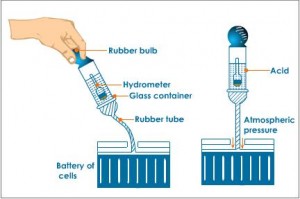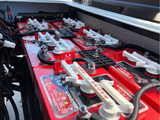What is a hydrometer and how do I read one?
A hydrometer is used to determine the state of charge of each cell of a battery. The hydrometer will determine the cells specific gravity of electrolyte (its weight compared to water).
A hydrometer is a bulb or tear drop syringe which will extract electrolyte from the cell. A float in the hydrometer is calibrated to read in terms of specific gravity. A common range of specific gravity used in these floats is 1.160 to 1.325. A common specific gravity reading is 1.250 to 1.280 in most climates for a fully charged battery, with a reading of 1.210 to 1.230 in tropical climates. A tropical climate is considered one in which water never freezes. In extremely cold climates, most batteries use a stronger electrolyte solution. A specific gravity reading for this climate could be 1.290 to 1.330. A higher specific gravity reading can, in most cases, decrease the service life of the battery.
 Should a reading occur in which the float does not float, you can assume that the cell is bad or that the battery has been fully discharged at the time of the reading. In this case, it may take several hours on a charger to reach the minimum specific gravity level of 1.160 (approximately 1/2 charged). Remember, the lower the float drops in the electrolyte, the lower its specific gravity, the lower the charge.
Should a reading occur in which the float does not float, you can assume that the cell is bad or that the battery has been fully discharged at the time of the reading. In this case, it may take several hours on a charger to reach the minimum specific gravity level of 1.160 (approximately 1/2 charged). Remember, the lower the float drops in the electrolyte, the lower its specific gravity, the lower the charge.
| State of Charge | Specific Gravity as used in Cold and Temperate Climates | Specific Gravity as used in Tropical Climates |
| Fully Charged | 1.265 | 1.225 |
| 75% Charged | 1.225 | 1.185 |
| 50% Charged | 1.190 | 1.150 |
| 25% Charged | 1.155 | 1.115 |
| Discharged | 1.120 | 1.080 |
Recent Posts
-
Powerstride’s Proper Battery Care Tip # 1
New batteries should be given a full charge before useThis is a very “common sense” tip! To ge …Apr 12th 2024 -
Aerial Lift Battery Basics
Aerial Lift Battery BasicsOne of the most important tools you have on your job site might be your ae …Feb 27th 2024 -
Golf Cart Battery Basics (UPDATED FOR 2024)
Golf cart batteries are vital to how well a golf cart runs. The batteries can affect speed, accele …Feb 15th 2024



